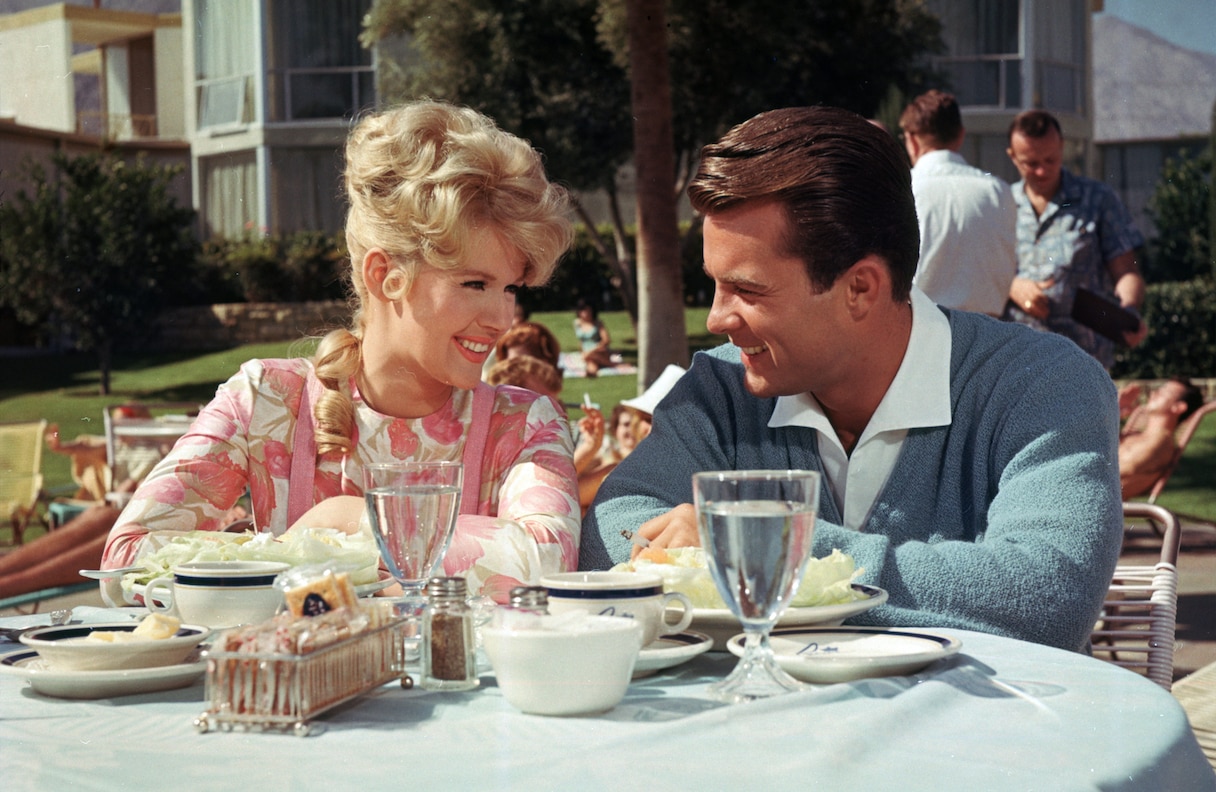MARIANI’S
Virtual
Gourmet
January 15. 2023
NEWSLETTER
IN THIS ISSUE
EATING AROUND WALT DISNEY WORLD
PART TWO
By John Mariani
NEW YORK CORNER
TRENDS FOR NY'S RESTAURANT SCENE IN 2023
By John Mariani
GOING AFTER HARRY LIME
CHAPTER THREE
By John Mariani
❖❖❖
 Isenberg on
his book about Hollywood director Billy
Wilder. Go to: WVOX.com.
The episode will also be archived at: almostgolden.
Isenberg on
his book about Hollywood director Billy
Wilder. Go to: WVOX.com.
The episode will also be archived at: almostgolden.❖❖❖
EATING AROUND WALT DISNEY WORLD
PART TWO
By John Mariani
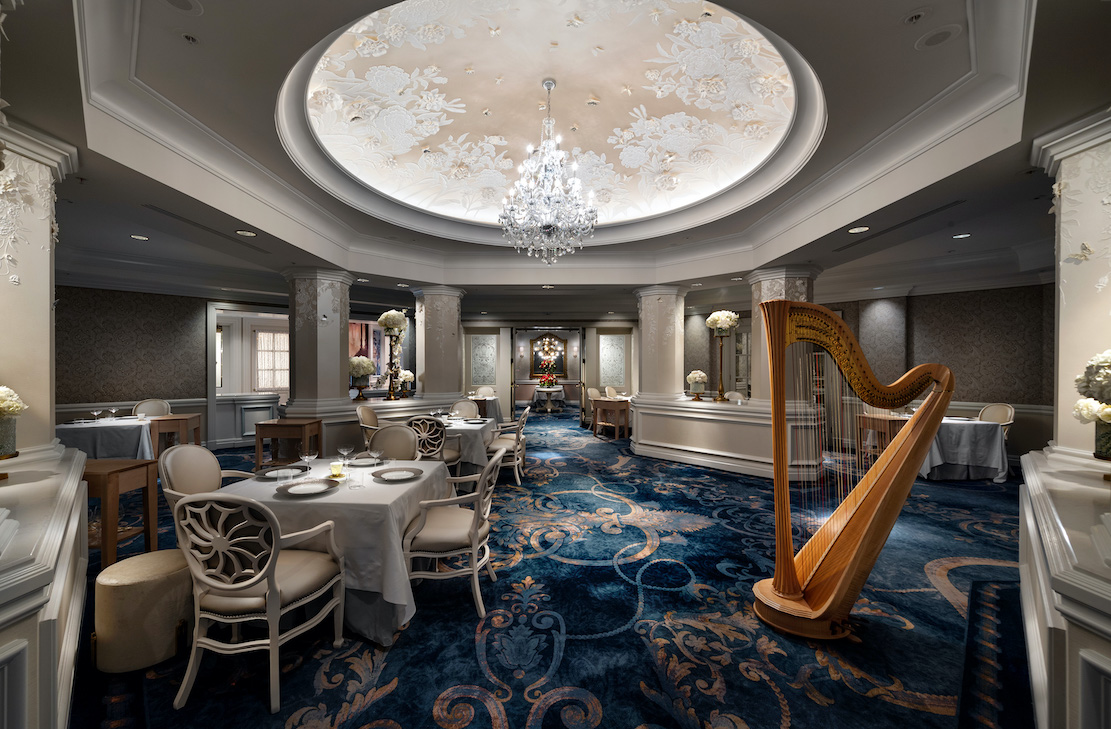
Victoria & Albert at The Grand Floridian Resort
Tiffins has
re-opened within Disney’s Animal Kingdom
theme park,
and in its design and exotic theme it
is one of the most impressive within the
parks and outside of a resort hotel, dedicated
to “seafarers, fortune hunters and
vagabonds.” Different dining rooms’ walls
are hung with African elephant art; a
ceiling arches over carved wooden totems,
with artwork inspired by the actual notes
and field sketches (on display) by the
creators of the Animal Kingdom, who spent
months in Africa, India and Asia doing
research. The name Tiffins refers to the
light lunch served in tiered containers and
consumed by working men in India.
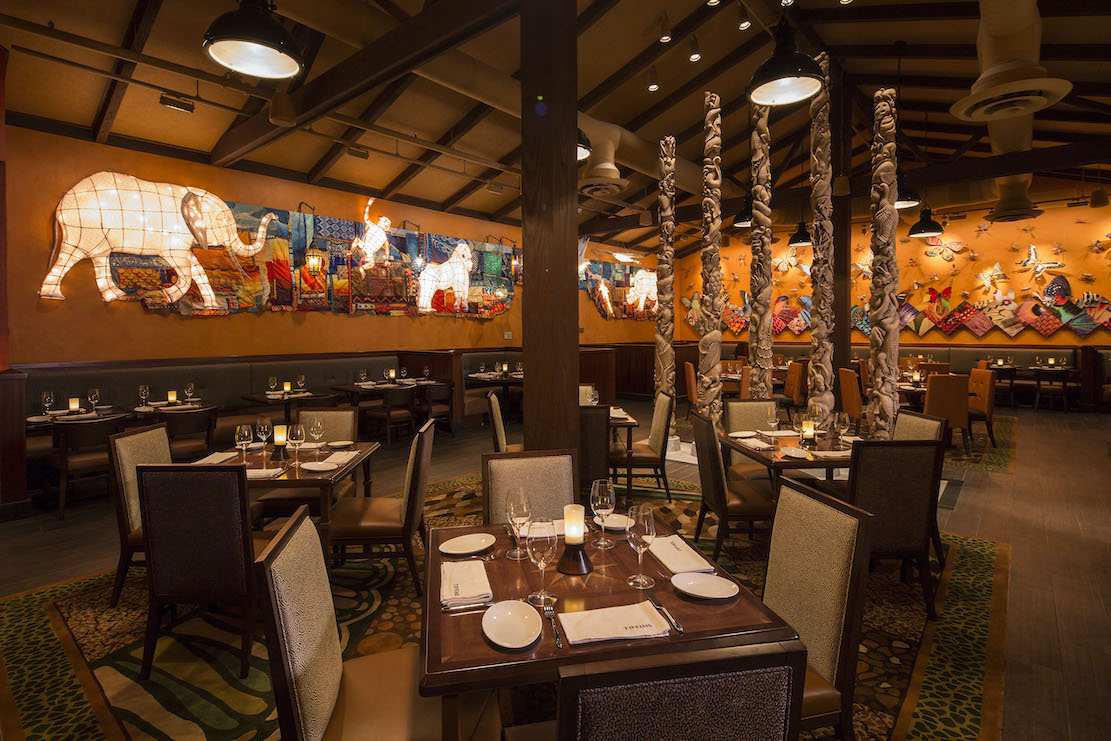 There’s
also a bar/lounge with rattan chairs and
couches, where a number of specialty cocktails
with names like Snow Leopard Salvation and
Tempting Tigress are served, along with wine and
beer tasting flights.
There’s
also a bar/lounge with rattan chairs and
couches, where a number of specialty cocktails
with names like Snow Leopard Salvation and
Tempting Tigress are served, along with wine and
beer tasting flights.
During the pandemic chef Camilo Velasco,
from Colombia, and his team had the time to
create, change and fine tune dishes derived from
many cuisines, which begins with a bread service
with coconut curry and guava sauces and ginger
pear chutney ($14). Seasonings
are not held back where warranted. 
The salad’s young lettuces and vegetables
are grown at EPCOT’s Land Pavilion, and served
with walnut-roasted tomato Mohammara dip from
Aleppo and the Middle East, along with garlic
bread crumbs, feta sumac and citrus vinaigrette
($13). The
spiced chickpea falafel with mint pistachio
pesto, cumin-scented garlic raita yogurt and
pickled vegetables was a superb mélange of
flavors for an ingredient that easily can be
bland ($10).
There is also a nicely charred octopus
with grilled corn salsa, chorizo, a dash
of tequila, and a mole negro
with pickled onions and cilantro ($18). Although
listed as an appetizer, the honey and
chili-glazed pork belly with chorizo, goat’s
cheese biscuit and spicy hot tasso ham is
further enriched with a poached egg ($15) and
could readily serve as a main course.
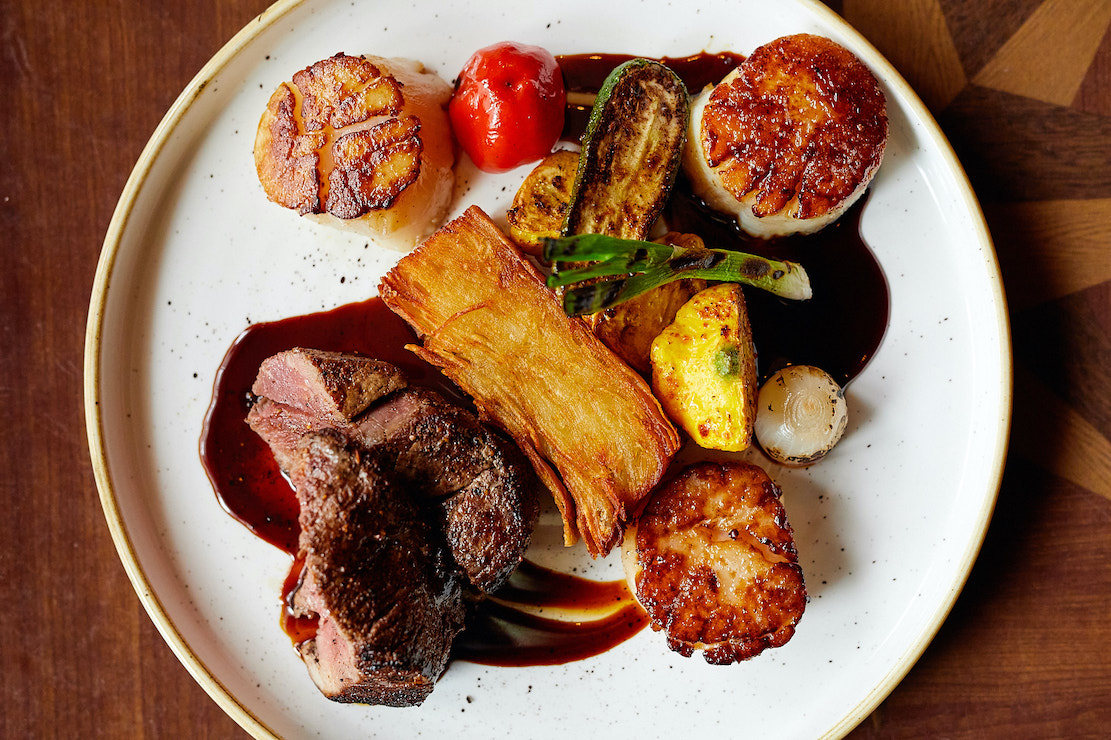 Among
the mains, there’s a whole fried fish of the
day, all from sustainable species, with coconut
fried rice, green and red curry, a Thai green
papaya slaw and crunchy peanuts ($44). Tofu
is another ingredient that
needs help to make it delectable, and here it is
chermoula marinated and suffused with North
African spices, seasonal vegetables and tomato
chutney ($32 ).
Among
the mains, there’s a whole fried fish of the
day, all from sustainable species, with coconut
fried rice, green and red curry, a Thai green
papaya slaw and crunchy peanuts ($44). Tofu
is another ingredient that
needs help to make it delectable, and here it is
chermoula marinated and suffused with North
African spices, seasonal vegetables and tomato
chutney ($32 ).
Tiffins’s version of surf
and turf is composed of South African spiced
beef tenderloin and seared scallops cooked on a
South African braai grill,
with a potato parfait, coriander butter and cola
demi-glace ($65). Veal is similarly spiced and
served with a creamy mushroom ragôut and
truffled polenta and black garlic ($52).
Although a dish called “butter chicken” ($39)
was enjoyable, sided with a chickpea croquette,
English peas, young squash and pickled onions,
it is not what most people would think of as
typical Indian butter chicken with its rich
tomato-cream
sauce.
Deserts
are more western in style, though they keep
thematic names like the Lion King ($15), made of luscious
caramel mousse with a chocolate brownie and
strawberry mango sauce; lemon meringue pie is
wonderfully American, with ginger-lemon curd,
lemon gel, buttery madeleine cake, graham
cracker cookie and a lemon basil sauce ($13).
Inside the Hollywood
Studios is the beguiling replica of
the famous
Brown
Derby restaurant.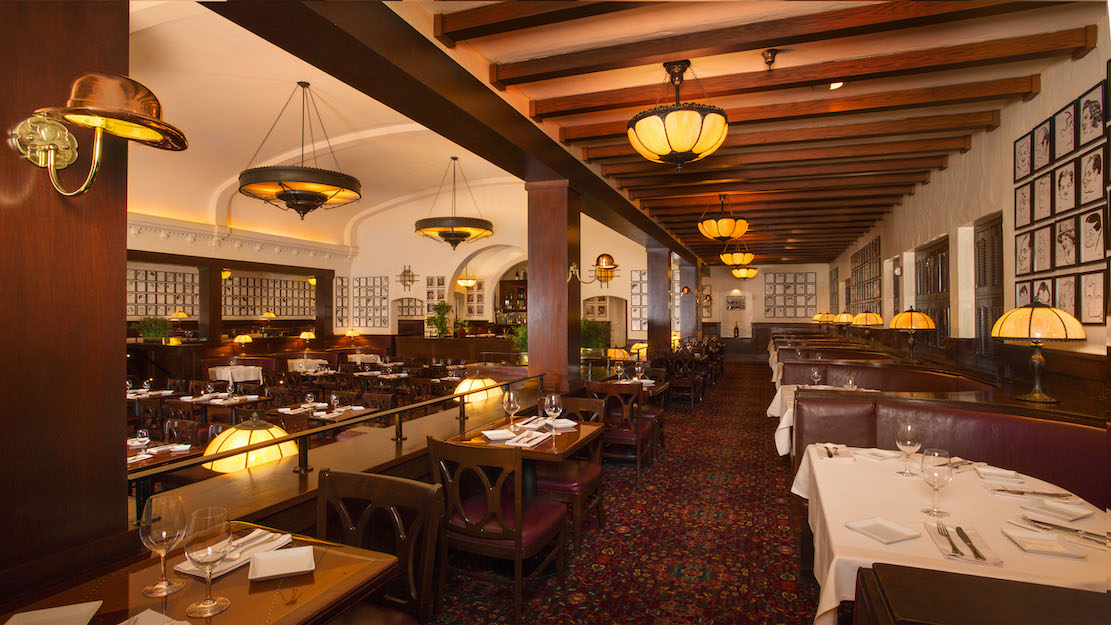 Owing to my
nostalgia for Old Hollywood and not having been
around in those days when the original Brown
Derby opened in 1926 and had a movie star
clientele whose caricatures lined the walls, I
have always enjoyed Disney’s evocative version
of this legendary restaurant.
Owing to my
nostalgia for Old Hollywood and not having been
around in those days when the original Brown
Derby opened in 1926 and had a movie star
clientele whose caricatures lined the walls, I
have always enjoyed Disney’s evocative version
of this legendary restaurant.
The story goes that at a time when
Hollywood restaurants had fanciful names like
Kit Kat Club, Monkey Farm and Coconut Grove,
Gloria Swanson’s ex-husband, 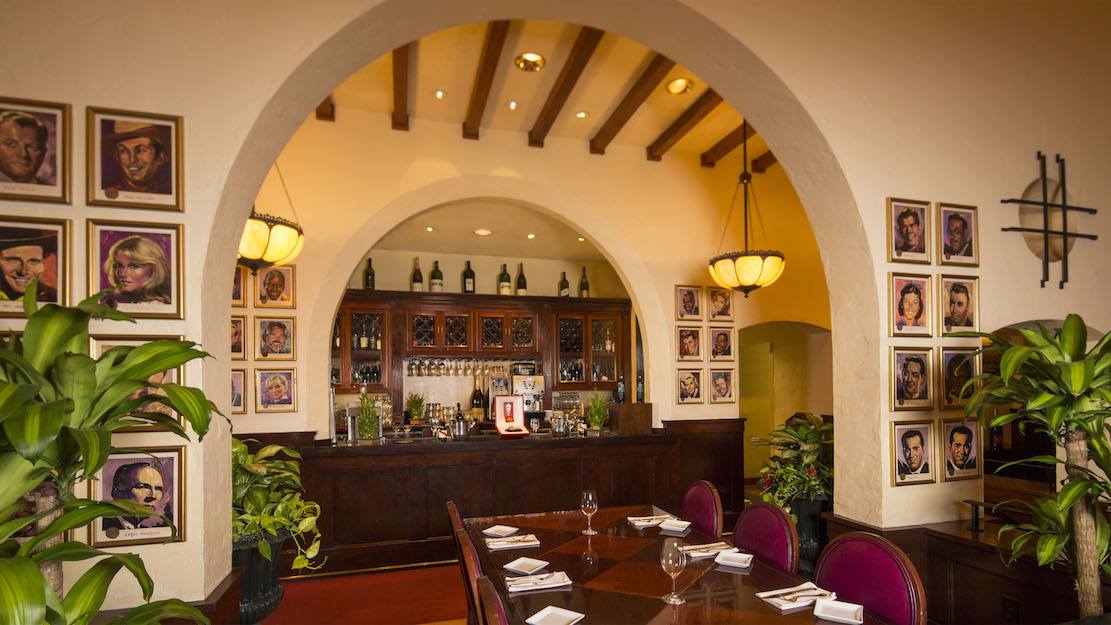 Herbert
Somborn, quipped, “You could open a restaurant
in an alley and call it anything. If the food
and service were good, the patient will just
come flocking. It could even be called something
as ridiculous as the Brown Derby.” He himself
thereupon did so, opening in a brown building
shaped like a derby hat.
Herbert
Somborn, quipped, “You could open a restaurant
in an alley and call it anything. If the food
and service were good, the patient will just
come flocking. It could even be called something
as ridiculous as the Brown Derby.” He himself
thereupon did so, opening in a brown building
shaped like a derby hat.
Inside the Disney version enormous care
has been taken to reproduce the look of the
original, with its archways, dark wood and buff
color, roomy booths, chandeliers, brass fixtures
and hundreds of caricatures of Old Hollywood
stars.
The menu also brings back some of the
famous dishes, like the chopped salad named
after owner Robert Cobb in 1937 that, along with
the Caesar salad, is one of the greatest
American contributions to gastronomy, here made
with spit-roasted turkey, bacon, boiled egg,
tomatoes, and blue cheese ($22). Crab Louis
($17), which comes from San Francisco’s Solari’s
restaurant as of 1914, is faithfully rendered at
Disney.
There are classics like smoky roasted bone marrow with gold mustard seeds and fig
bread crostini
($17) and duck à l’orange
with broccolini and leg confit ($38) is a
reminder of how good this dish used to be, as
does the meaty coq au vin
with pan-fried tomatoes, trumpet mushrooms,
smoked bacon and a red wine reduction ($35).
Tomato risotto ($31) seemed like the
out-of-character dish on the menu and lacked a
depth of flavor.
bone marrow with gold mustard seeds and fig
bread crostini
($17) and duck à l’orange
with broccolini and leg confit ($38) is a
reminder of how good this dish used to be, as
does the meaty coq au vin
with pan-fried tomatoes, trumpet mushrooms,
smoked bacon and a red wine reduction ($35).
Tomato risotto ($31) seemed like the
out-of-character dish on the menu and lacked a
depth of flavor.
For dessert you can even get New
Orleans’s bananas foster on an apple cider cake
($12) and a good old-fashioned chocolate coconut
cake with hazelnut ice cream ($12).
The Brown Derby has a serious wine list,
with plenty of good bottles under $70, while its
“cocktails of the Stars,” and flights of
martinis and margaritas are impressive.
For decades, Disney’s flagship
restaurant has been the Dining
Room at Victoria & Albert in the Grand
Floridian resort. Windowless, it was once a
circular room of Victorian posh right down to
the uniforms of the staff. It was all a bit too
kitschy, but the menu, formerly under chef Scott
Hunnel, was a stunning 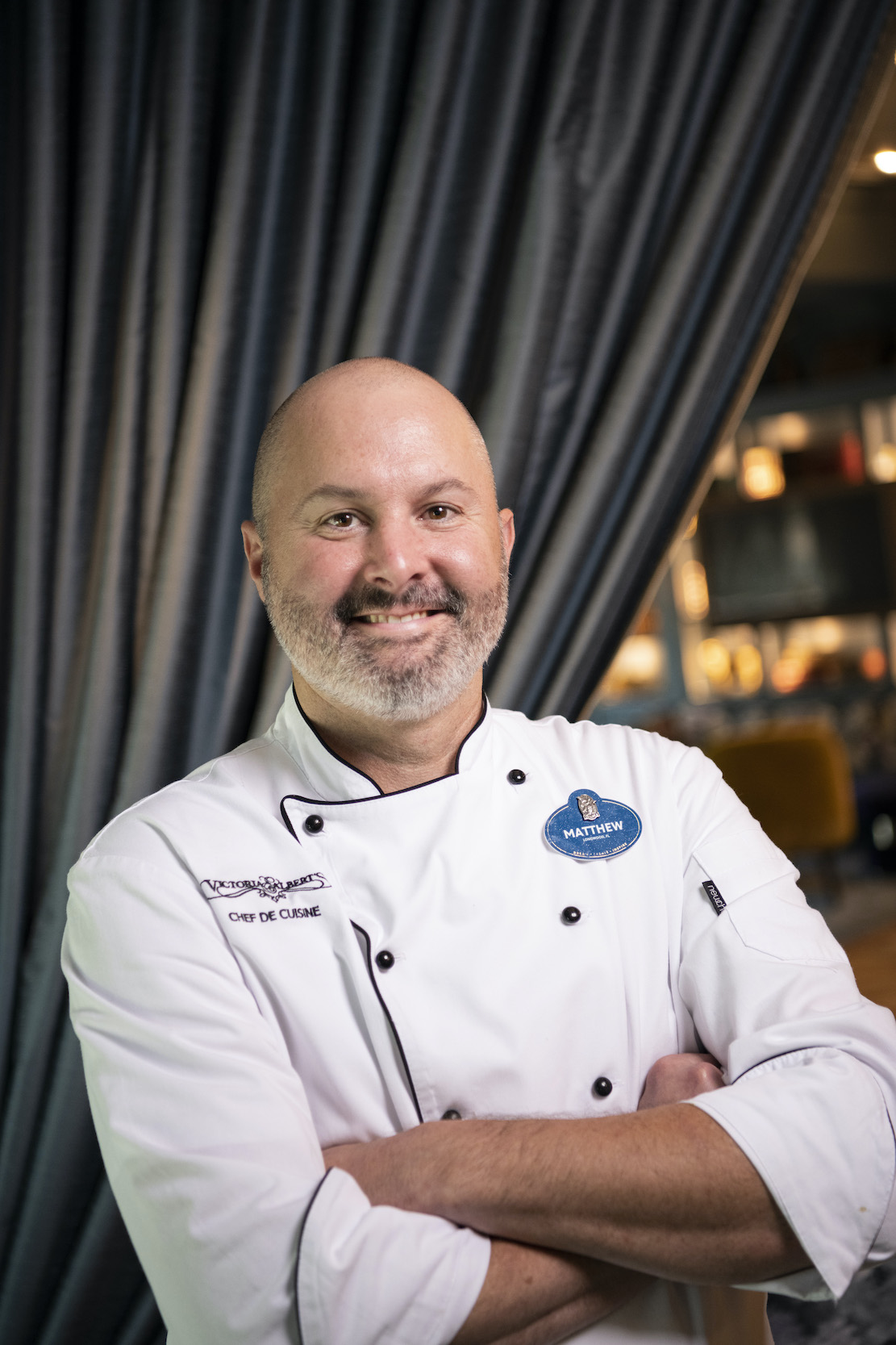 example
of how high the company wanted to aim in order
to compete with the finest restaurants in
America. It was very extravagant, very expensive
and always booked for dinner months in advance.
example
of how high the company wanted to aim in order
to compete with the finest restaurants in
America. It was very extravagant, very expensive
and always booked for dinner months in advance.
And since re-opening, with Chef Matthew
Sower (left) in the kitchen, it still is,
with two tasting menus, a $295 set menu of nine
courses and $375 for eleven, and a truly
extraordinary wine list. One can also book a
prized single table in the kitchen itself, where
you can watch your meal being prepared, though I
much prefer dining in a proper dining room, with
all its decorative appeal and the pleasure of
being surrounded by other guests. 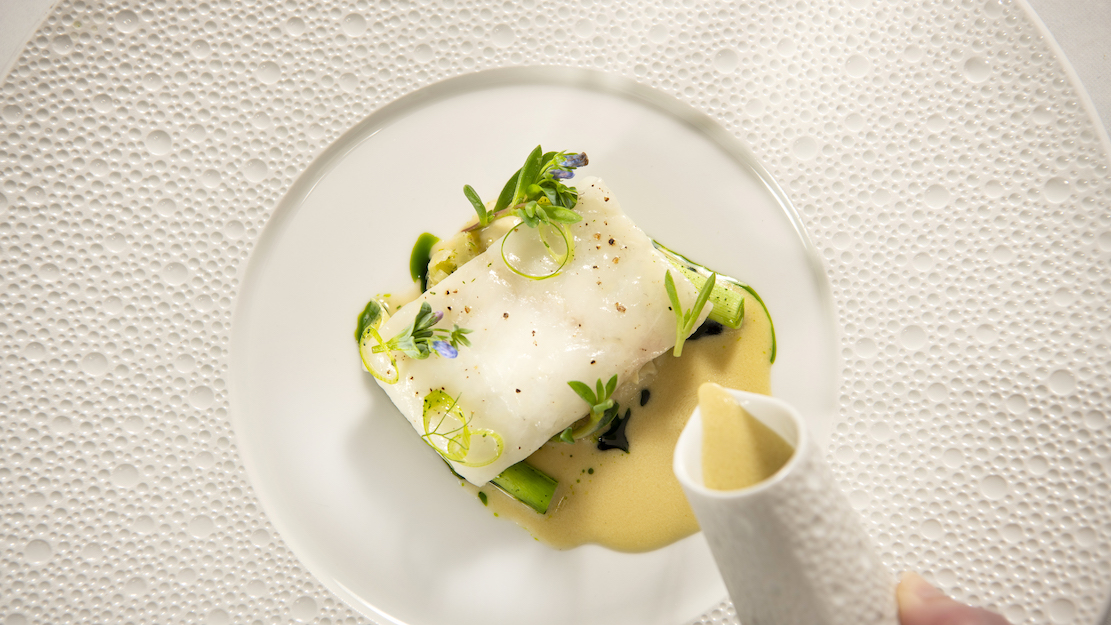
As re-cast, the room has a beautiful
central rotunda whose light spreads onto the
tables and whose perimeter is ringed with large
sprays of flowers. Outside that perimeter are
the rest of the tables, though the lighting
there, on pale gray walls, is low, detracting
from guests being able to appreciate the beauty
of chef Sower’s careful plate presentations.
You need to be prepared for a three- or
four-hour meal whose individual dishes are
described by a captain who will detail every
ingredient and sauce down to its microgreens, as
will the sommelier with the wines, which adds up
to a lot of time (although Scott Hunnel has
since told me this dated procedure is being
tweaked).
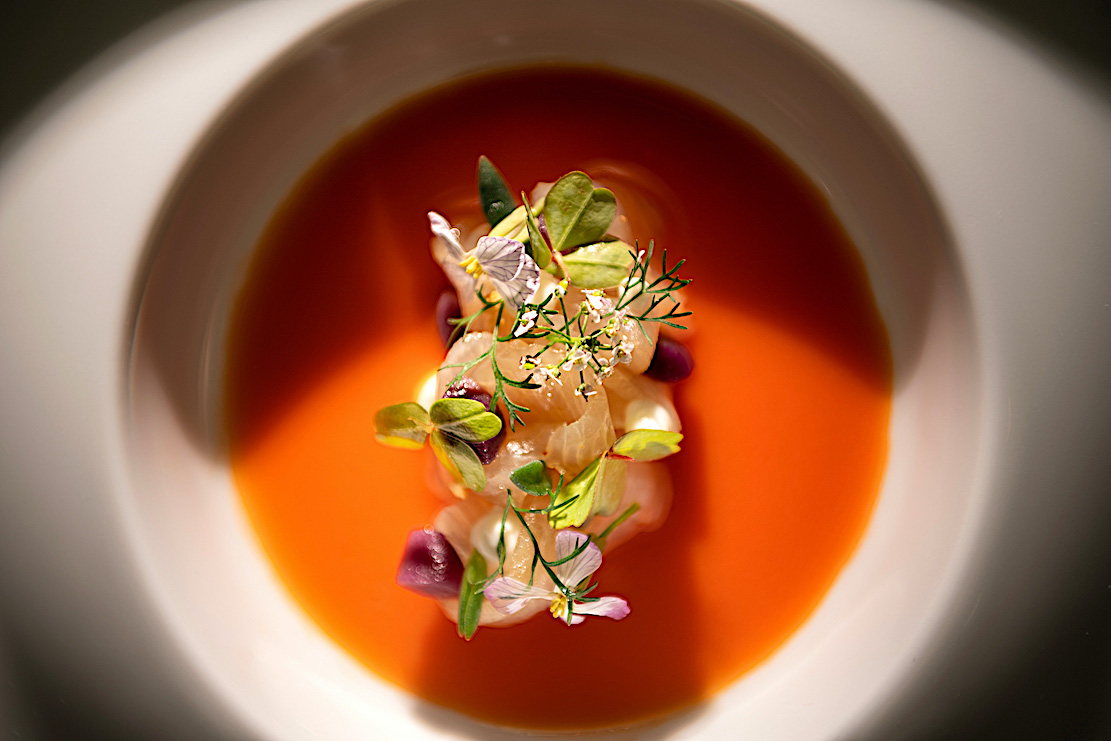 That said,
Sower’s cuisine is as stunning as his
predecessor’s, as is the work of pastry chef
Kristine Farmer.
That said,
Sower’s cuisine is as stunning as his
predecessor’s, as is the work of pastry chef
Kristine Farmer.
I haven’t the space to list everything
among the tasting menus my wife and I enjoyed,
but we began with Belgian caviar with a
cauliflower puree and lustrous Danish hiramasa (yellowtail)
with carrot and Okinawa potatoes. (There are a lot of
foreign ingredients used.) Wild turbot from
Portugal was scented with fennel and baby leeks,
while toothfish came with charred mushrooms and
a spicy Asian sambal. Among the meat courses
were Rohan duck with Black Mission figs  and
a balsamic vinegar to cut the sweetness, and
Colorado bison with maple-glazed potatoes.
and
a balsamic vinegar to cut the sweetness, and
Colorado bison with maple-glazed potatoes.
Farmer’s desserts were as lovely to look
at as to eat, including a “spectrum” of
chocolate (right); and crème fraiche ice
cream with a warm crème brûlée cookie.
This is cuisine of a high order, based on
rare ingredients and attention to detail. I do
hope some of the effusive presentations will be
cut back, but this would be a very special night
out anywhere.
❖❖❖
TRENDS IN NYC RESTAURANTS
FOR 2023
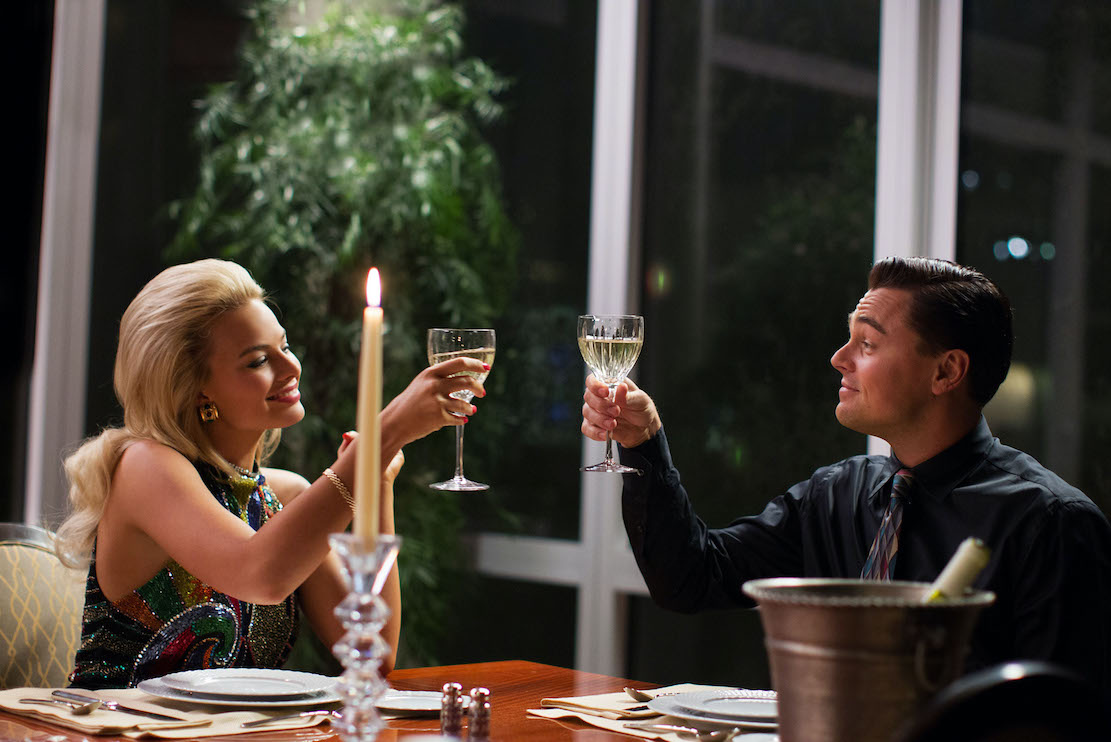
Margot Robbie and Leonardo di Caprio in "The Wolf of Wall Street" (2013)
As I predicted, the New York restaurant industry is on
a soaring trajectory post-pandemic, despite
fears of recession and, most important, a
continuing lack of qualified staff, both in and
out of the kitchen. Not only are restaurants in
New York full—especially during the recent
holidays—but significant new ones open every
week with no sign of stopping. Hope
springs eternal in the New York restaurant
sector, for as soon as one place closes, another
one opens, and with so many landlords desperate
to fill office buildings they have been willing
to make good (well, at least reasonable) deals
with restaurateurs over spaces the realtors
cannot afford to stay empty. Restaurants are
both an anchor and a draw for a building, as
well as manifesting a vitality.
So here’s what I believe will be the
trends in New York restaurants for 2023. The
rest of the country may not show such
resilience, but no one should ever doubt the
draw of Gotham’s gastronomy.
 Travelers
are back. Like a
bursting dam, foreigners and out-of-towners are
booking hotels and restaurants post-Covid. Pent-up
desire and held-back money—despite a strong
dollar—are bringing in the Europeans and South
Americans, though Asians have been slow to
respond. Also, foreign travelers are as ravenous
as domestic visitors to eat at restaurants they
can’t find back home. The city expects to attract
61.3 million visitors in 2023, up 8.6% from last
year, when international visitors more than
tripled.
Travelers
are back. Like a
bursting dam, foreigners and out-of-towners are
booking hotels and restaurants post-Covid. Pent-up
desire and held-back money—despite a strong
dollar—are bringing in the Europeans and South
Americans, though Asians have been slow to
respond. Also, foreign travelers are as ravenous
as domestic visitors to eat at restaurants they
can’t find back home. The city expects to attract
61.3 million visitors in 2023, up 8.6% from last
year, when international visitors more than
tripled.
Fewer
tasting menus. If you
counted the number of people who even like
12-course tasting menus, I doubt you’d find more a
thousand seats per night filled at such
restaurants, where four-hour meals of tiny morsels
and too much wine go for extravagant prices. Few
restaurateurs are going to take the chance to find
their audience to plan out the intricacies of such
a meal’s ingredients, service and even the china.
Fewer
trophy wine lists. A cogent,
well selected wine list is more impressive than
one that carries hundreds of label names (with
perhaps one bottle in the cellar), because it
indicates what wines go well with the chef’s food.
The capital expenditure for a trophy list is now
outrageous, with fewer Chinese and Russian
billionaires around to show off.
No
ethnic “food of the year.” Media
feel the need to declare a kind of food the
trendiest of a year. Remember Nordic cuisine? Last
year it was Mexican. The year before Korean. This
year I predict there will be no single cuisine
that stands out because of media hype.
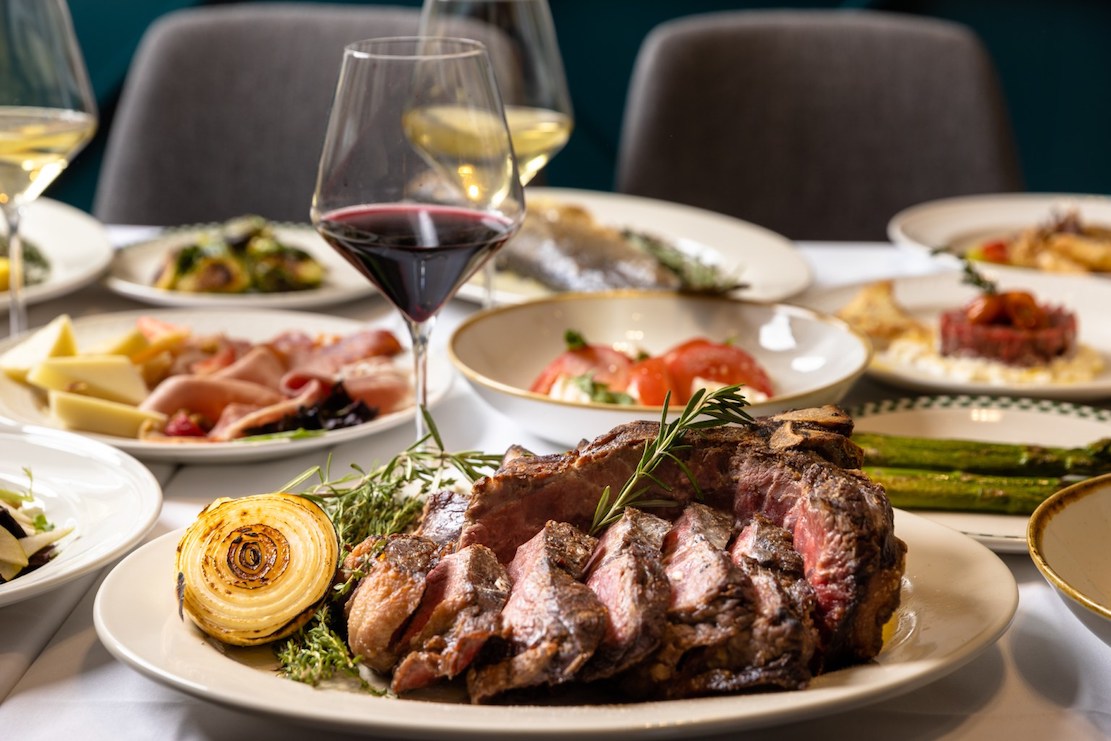 A
surfeit of steakhouses. To a
sure degree, opening up an expensive steakhouse is
a no brainer, and in the past two years they’ve
popped up everywhere, and all do good business.
But this year that trend will slow, mainly because
there is now a surfeit of them and too much
competition, especially in Manhattan. In just the
last couple of years COTE NYC, St. Anselm, Gage
& Tollner, American Cut, Bowery Meat Co.,
Hawksmoor, Valbella and Ramerino Tuscan Prime (left)
all have been added, so it’s not clear how many
more the city can absorb.
A
surfeit of steakhouses. To a
sure degree, opening up an expensive steakhouse is
a no brainer, and in the past two years they’ve
popped up everywhere, and all do good business.
But this year that trend will slow, mainly because
there is now a surfeit of them and too much
competition, especially in Manhattan. In just the
last couple of years COTE NYC, St. Anselm, Gage
& Tollner, American Cut, Bowery Meat Co.,
Hawksmoor, Valbella and Ramerino Tuscan Prime (left)
all have been added, so it’s not clear how many
more the city can absorb.
More
seafood. The
supply of first quality seafood is never going to
be adequate, which is why every restaurant in the
city now serves farm-raised branzino. Still, New
York does not have a plethora of seafood places
below the paragon of Le Bernardin. But I think
there will be some proliferation along the
riverside neighborhoods on the Hudson and East
River that will offer a wide variety of seafood.
Harlem
Boom. With
residential home sales soaring in Harlem and the
expansion of Columbia University into the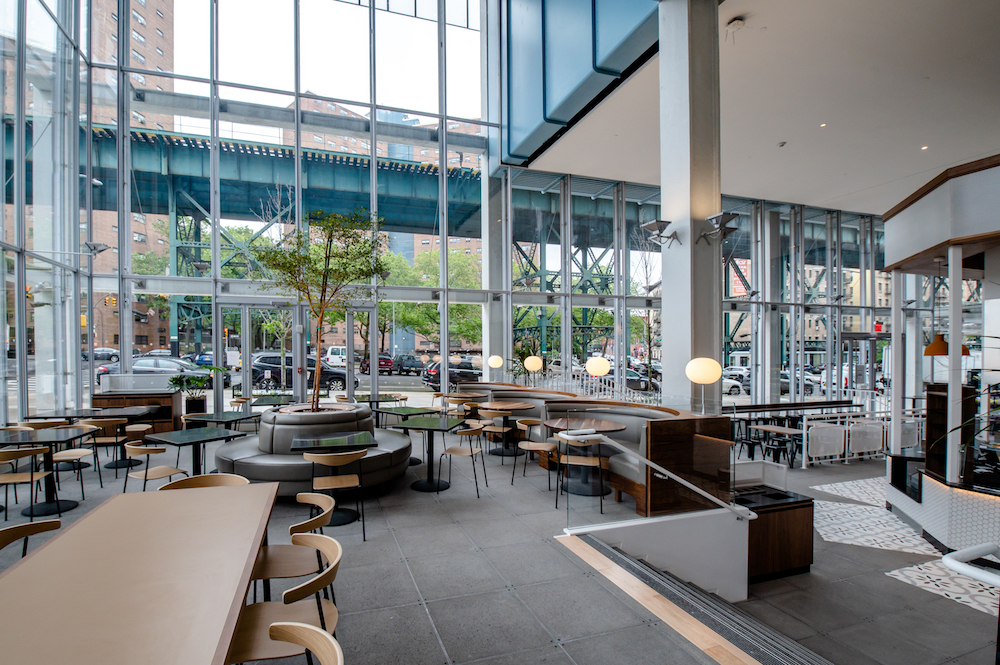 Upper West Side, which will have tens of thousands
employees, students and apartment dwellers who
want to eat locally, restaurants in Harlem should
boom this year, especially west of Park Avenue.
Places like Harlem Public, Fumo Harlem, Fieldtrip
Harlem, Melba’s, Renaissance Harlem and Oliva
Tapas (right) have proven to attract people
from all over the city.
Upper West Side, which will have tens of thousands
employees, students and apartment dwellers who
want to eat locally, restaurants in Harlem should
boom this year, especially west of Park Avenue.
Places like Harlem Public, Fumo Harlem, Fieldtrip
Harlem, Melba’s, Renaissance Harlem and Oliva
Tapas (right) have proven to attract people
from all over the city.
Vegetarian
options. Instead
of more vegetarian restaurants, more and more
menus will offer more and more vegetable dishes
outside the usual spinach and broccoli, not least
more regional pastas and Asian restaurants using
Asian greens. The switch of Eleven Madison Park to
an all-vegetarian menu hasn’t spurred others to do
so.
Regional
Italian. You’d
think that New York would have just about every
region of Italy covered, from Trieste to Sicily,
but the vast majority of the city’s Italian
restaurants cover the boot, with favorite southern
and a few northern dishes. Now, though, I expect
to see more menus reflecting regions like Abruzzo,
Liguria, Puglia, Sardinia and others that will
distinguish them from their competitors.
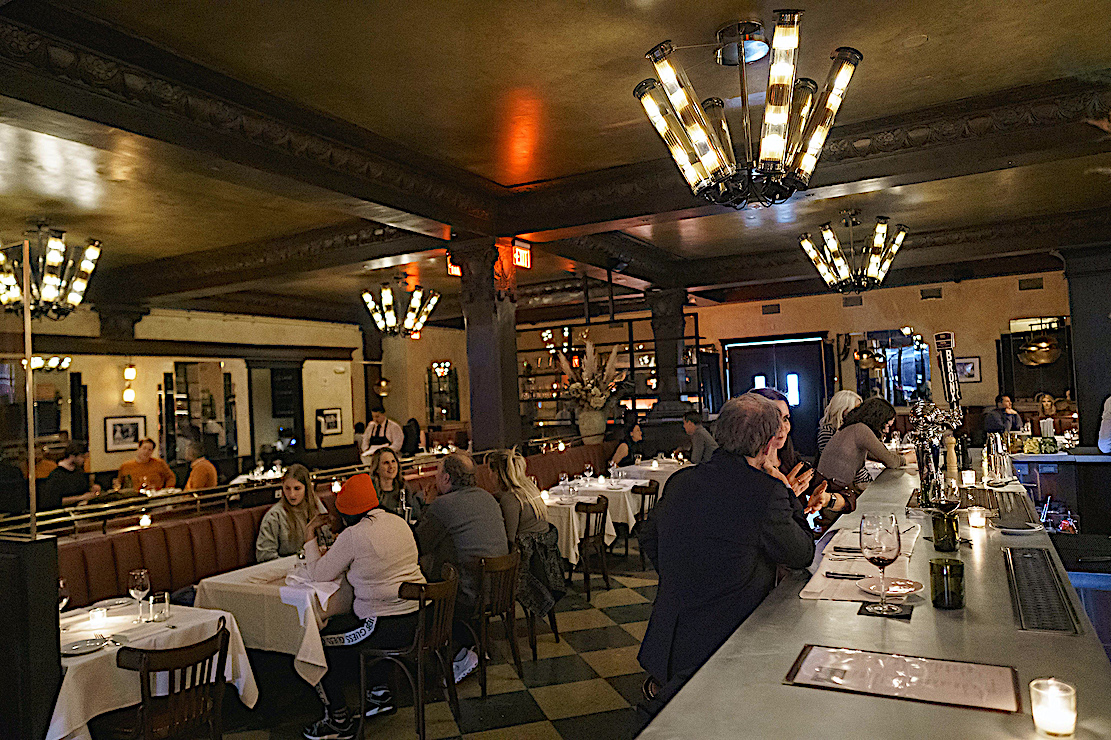
Moderate
French. New
York may well have a sufficient number
of grand French restaurants, even though some food
media have been predicting their demise for
decades. But in the next year I see a return to
bistro and brasserie interest, with comfortable,
cozy atmosphere and the kinds of classic French
dishes that never went out of style, as evidenced
by new places like Corner Bar, La Brasserie (left),
Le Rock and Daniel Boulud’s Le Gratin.
Prices. The
great inflationary spiral may be peaking, after
causing everything from rutabagas to Prime beef to
soar. But, while diners continue to eat out as
much as they do, restaurateurs are always
sensitive to price and rare will be the one to
increase prices if the other guy’s don’t budge.
Based on my eating around NYC for the past year, I
find that full portions of pasta now average $25,
steaks $65 and desserts $14, not to mention $20
cocktails. 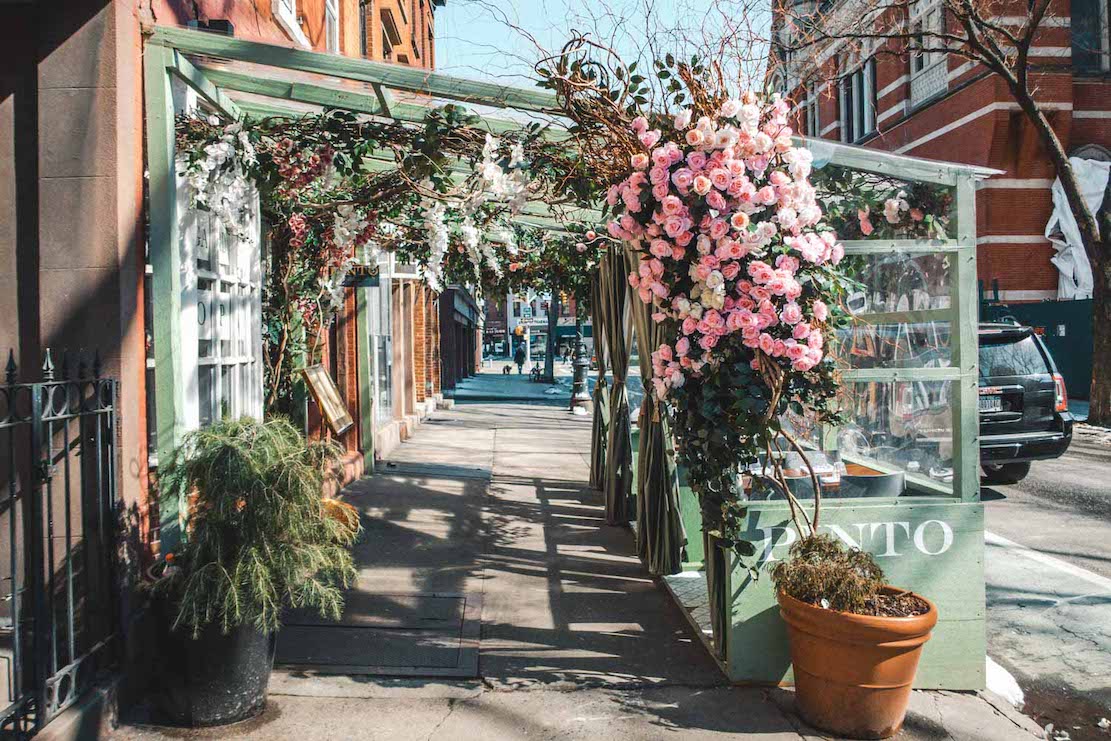
Outdoor
dining. Although
the municipal authorities have dragged their feet
on rules and regulations, it seems that outdoor
dining is here to stay in NYC. And restrictions on
simple tables on the sidewalk have gotten easier
for smaller storefronts.
❖❖❖
GOING AFTER HARRY LIME
By John Mariani

CHAPTER THREE
“A petty reason
perhaps why novelists more and more try to keep
a distance from journalists is that novelists
are trying to write the truth and journalists
are trying to write fiction.”—Graham Greene
Katie dug into the
background research she always did first:
primary sources, secondary sources, then requests
for interviews with people she thought might lead
her into further inquiries. She told David of the
arrangement with Dobell, and David was happy to
help any way he could, although it was not clear
how much help he could be in what was initially to
be a literary investigation.
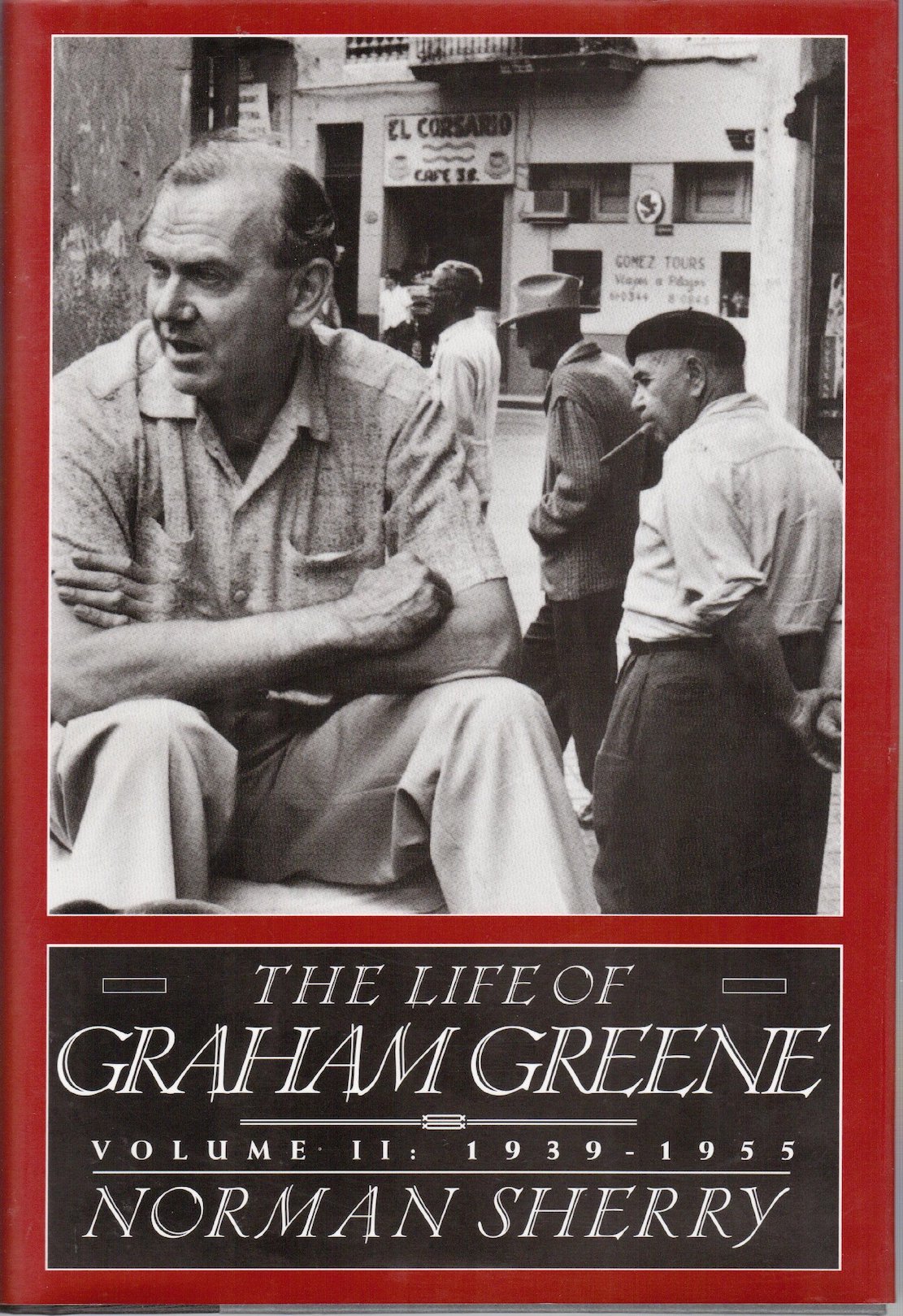 “Tell you what,” said
Katie. “You seem to know a lot about the movie, so
while I’m chasing after Graham Greene, how about
you find out what you can about the movie?”
“Tell you what,” said
Katie. “You seem to know a lot about the movie, so
while I’m chasing after Graham Greene, how about
you find out what you can about the movie?”
“Katie, I’m no film scholar. I wouldn’t
really know where to begin.”
“Pretend you’re looking for clues to Mafia
mob behavior by watching and researching mob
movies out of Hollywood and Italy. You
always said mobsters like John Gotti copied the
behavior and style they saw in the movies like The Godfather
and Goodfellas,
right? Y’know, life imitates art?”
“That’s a pretty thin line of
investigation,” said David, “but, hey, it’ll be
fun. I’ll get a DVR of The Third Man—they
probably have a copy at Blockbuster—and watch it
over and over for clues. What are you up to?”
“I’m reading all I can get my hands on
about Greene. There’s a recent two-volume
authorized bio of him by a guy named Norman
Sherry, and a collection of Greene’s letters just
came out this year. I love that kind of research.”
“I know you do. Okay, see what you come up
with and I will on my end.”
Katie had every intention of reading every
page of Sherry’s two 500-page volumes, but first
she just checked the index for any references to The Third Man,
Carol Reed, Orson Welles, and Harry Lime to get
some background. She figured that, since Greene
wrote the novella in 1948  and the movie came out a year
later, Sherry’s first volume, covering Greene’s
life from 1904-1939, was going to be useful only
as a peek into what made Greene tick as a young
man. The second volume, from 1939-1955, covered
the years most pertinent to Greene’s spy career
and The
Third Man. Katie felt a third volume, on the
years leading up to Greene’s death in 1991,
wouldn’t be very productive, nor was the final
volume likely to appear any time soon (the time
between the publication of the first two volumes
had been six years).
and the movie came out a year
later, Sherry’s first volume, covering Greene’s
life from 1904-1939, was going to be useful only
as a peek into what made Greene tick as a young
man. The second volume, from 1939-1955, covered
the years most pertinent to Greene’s spy career
and The
Third Man. Katie felt a third volume, on the
years leading up to Greene’s death in 1991,
wouldn’t be very productive, nor was the final
volume likely to appear any time soon (the time
between the publication of the first two volumes
had been six years).
Katie would read a chapter of the bio while
checking to see if there were any relevant
comments by Greene in the published letters. She
skipped around the letters when this or that name
came up, and, remembering that Harry Lime was
involved in selling bad—actually, diluted—penicillin,
she was excited to find a 1950 letter by Greene
written to a Roman Catholic chaplain in London
who’d insisted that there was no evidence that
diluted penicillin was dangerous, chiding Greene
by asking, “Is the story—as it seems to me—just a
leg-pull?”
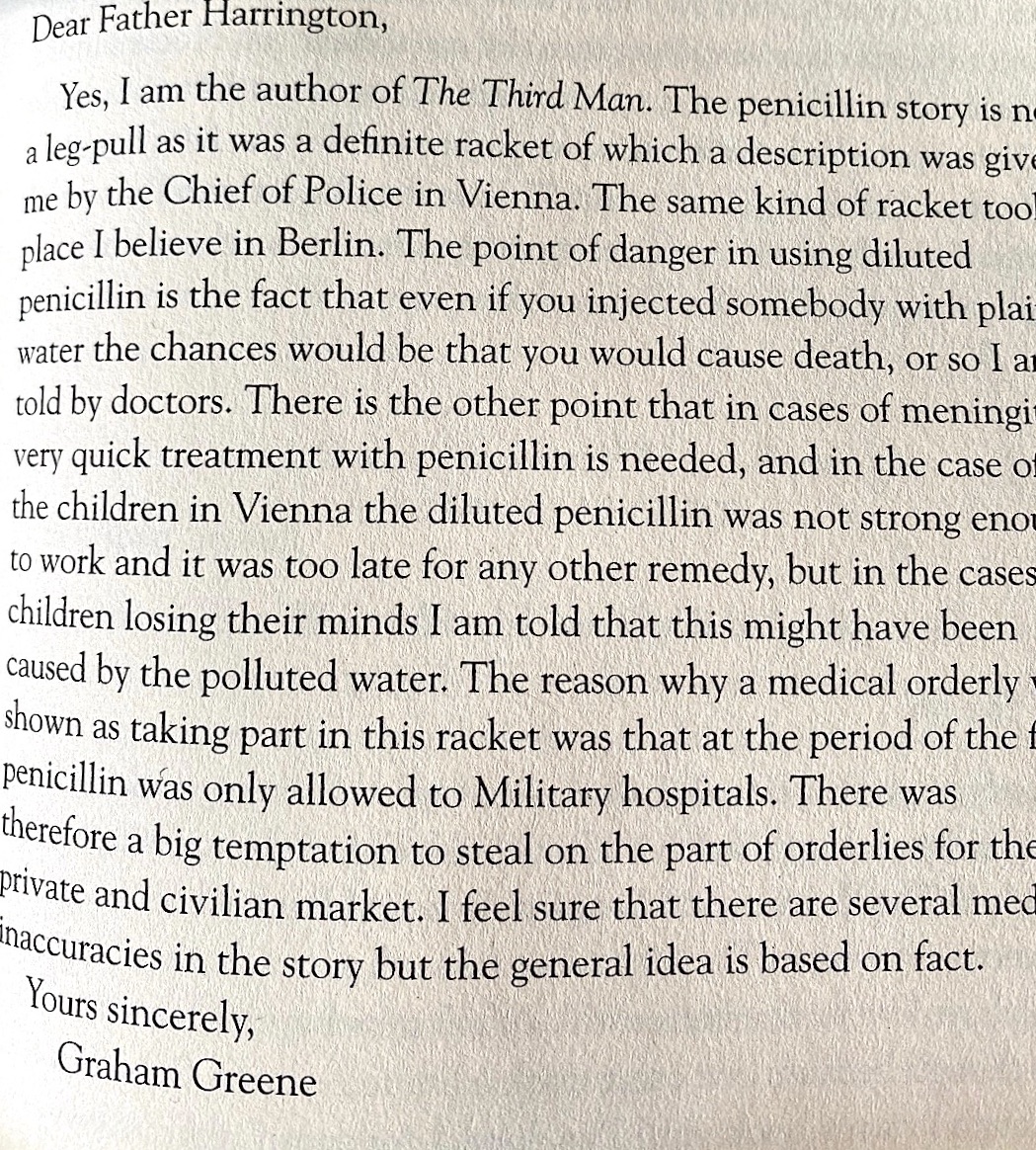 “Dear Father Harrington,”
Greene wrote back, “the penicillin story is not a
leg pull as it was a definite racket of which a
description was given to me by the chief of police
in Vienna. The same kind of racket took place I
believe in Berlin. The point of danger and using
diluted penicillin is the fact that even if you
injected somebody with plain water the chances
would be that you would cause death, or so I am
told by doctors. It was the other point that in
cases of meningitis very quick treatment with
penicillin is needed, and in the case of the
children in Vienna the diluted penicillin was not
strong enough to work and it was too late for any
other remedy, but in the case of the children
losing their minds I am told that this might of
been caused by the polluted water. I feel sure
that there are several medical inaccuracies in the
story but the general idea is based on fact.”
“Dear Father Harrington,”
Greene wrote back, “the penicillin story is not a
leg pull as it was a definite racket of which a
description was given to me by the chief of police
in Vienna. The same kind of racket took place I
believe in Berlin. The point of danger and using
diluted penicillin is the fact that even if you
injected somebody with plain water the chances
would be that you would cause death, or so I am
told by doctors. It was the other point that in
cases of meningitis very quick treatment with
penicillin is needed, and in the case of the
children in Vienna the diluted penicillin was not
strong enough to work and it was too late for any
other remedy, but in the case of the children
losing their minds I am told that this might of
been caused by the polluted water. I feel sure
that there are several medical inaccuracies in the
story but the general idea is based on fact.”
Finding out more about such drug sales
seemed a good place to start in her research,
beyond the Greene bios, so she called David to ask
whom they might speak to about such criminality
going back to the post-war years in Europe.
“That business with the bad penicillin is
gruesome stuff in the movie,” said David over the
phone. “That scene in the children’s hospital: All
Reed had to do was show Holly Martins’s face to
see how horrified he was at what his friend Harry
Lime had caused.”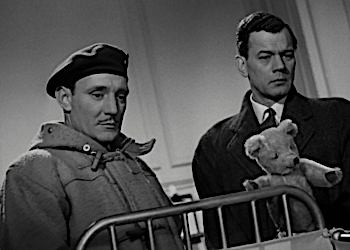
“I remember watching that and cringing,”
said Katie. “So do you know anyone who would have
knowledge, or even records, of such activity right
after the war?”
“I can see if Gerald Kiley has such info,”
said David, referring to the Interpol agent he and
Katie had worked with on the Vermeer case. “I think
Interpol was founded before World War II, and they
must have been pretty busy right after it.”
In fact, Interpol, under its original name
of the International Criminal Police Organization,
was founded in 1923 with the mission to coordinate
all worldwide criminal police authorities
in
dealing with international crimes ranging from
organized crime and drug trafficking to war crimes
and genocide. It took the name Interpol in 1956.
Gerald Kiley had been of enormous help on
the Vermeer case and David felt Interpol’s files
should contain info on the illicit drug trade in
Vienna in the post-war years.
David met Kiley at his office near the U.N.
building.
“So you haven’t retired yet?” asked David,
remembering that a year before Kiley had said he
would be by then.
“I will, just not yet,” said Kiley.
“Y’know, the older I get in this job the more I’m
intrigued by the vast number of truly despicably
evil people in this world who need to be put
behind bars.”
“Glad to hear it,” said David, “because I’m
here to ask you about one of the worst in post-war
Europe.”
“Who would that be?”
“Harry Lime.”
“Harry Lime? Wasn’t he the villain in The Third Man
movie?”
“Same guy.”
“But he was not a real person, David.”
“True, but Katie Cavuto has a notion that
it would fun to try to find out if Graham Greene,
the author, based Lime on a real person. Greene
had been in the British Secret Service during the
war. Katie thinks there’s a good story in trying
to find out if there not only was a
real Harry Lime but that he might still be alive
somewhere.”
“And, as with the Vermeer article, she’s
basing this on sheer supposition, without any
evidence?”
 “More like wish fulfillment. But, hey,
wherever Katie goes, I’m happy to follow.”
“More like wish fulfillment. But, hey,
wherever Katie goes, I’m happy to follow.”
“I figured that out a long time ago, David.
So, how am I supposed to help you this time, with
a bad guy who never lived?”
“Well, do you know if Interpol would have
info on any such drug crimes after the war?”
“That was long before my time, or anyone
else’s in the department, but I guess I can ask
around and see. We’ve been building a good
database over the past several years, so I’ll see
if there’s anything there. Otherwise, if there is
info on that period, it’s likely to be in our
headquarters in Lyon, France (left). I
doubt very much stuff that old has been
transferred from old paper folders to computer
discs. I can ask.”
“That would be great. I’m sure Katie
wouldn’t mind a trip to Lyon.”
“With you in tow, I suppose.”
“Never occurred to me.”
© John Mariani, 2017
❖❖❖
Any of John Mariani's books below may be ordered from amazon.com.
 The Hound in Heaven
(21st Century Lion Books) is a novella, and
for anyone who loves dogs, Christmas, romance,
inspiration, even the supernatural, I hope you'll find
this to be a treasured favorite. The story
concerns how, after a New England teacher, his wife and
their two daughters adopt a stray puppy found in their
barn in northern Maine, their lives seem full of promise.
But when tragedy strikes, their wonderful dog Lazarus and
the spirit of Christmas are the only things that may bring
his master back from the edge of despair.
The Hound in Heaven
(21st Century Lion Books) is a novella, and
for anyone who loves dogs, Christmas, romance,
inspiration, even the supernatural, I hope you'll find
this to be a treasured favorite. The story
concerns how, after a New England teacher, his wife and
their two daughters adopt a stray puppy found in their
barn in northern Maine, their lives seem full of promise.
But when tragedy strikes, their wonderful dog Lazarus and
the spirit of Christmas are the only things that may bring
his master back from the edge of despair. WATCH THE VIDEO!
“What a huge surprise turn this story took! I was completely stunned! I truly enjoyed this book and its message.” – Actress Ali MacGraw
“He had me at Page One. The amount of heart, human insight, soul searching, and deft literary strength that John Mariani pours into this airtight novella is vertigo-inducing. Perhaps ‘wow’ would be the best comment.” – James Dalessandro, author of Bohemian Heart and 1906.
“John Mariani’s Hound in Heaven starts with a well-painted portrayal of an American family, along with the requisite dog. A surprise event flips the action of the novel and captures us for a voyage leading to a hopeful and heart-warming message. A page turning, one sitting read, it’s the perfect antidote for the winter and promotion of holiday celebration.” – Ann Pearlman, author of The Christmas Cookie Club and A Gift for my Sister.
“John Mariani’s concise, achingly beautiful novella pulls a literary rabbit out of a hat – a mash-up of the cosmic and the intimate, the tragic and the heart-warming – a Christmas tale for all ages, and all faiths. Read it to your children, read it to yourself… but read it. Early and often. Highly recommended.” – Jay Bonansinga, New York Times bestselling author of Pinkerton’s War, The Sinking of The Eastland, and The Walking Dead: The Road To Woodbury.
“Amazing things happen when you open your heart to an animal. The Hound in Heaven delivers a powerful story of healing that is forged in the spiritual relationship between a man and his best friend. The book brings a message of hope that can enrich our images of family, love, and loss.” – Dr. Barbara Royal, author of The Royal Treatment.
 |
The Encyclopedia of American Food and Drink by John F. Mariani (Bloomsbury USA, $35) Modesty forbids me to praise my own new book, but let me proudly say that it is an extensive revision of the 4th edition that appeared more than a decade ago, before locavores, molecular cuisine, modernist cuisine, the Food Network and so much more, now included. Word origins have been completely updated, as have per capita consumption and production stats. Most important, for the first time since publication in the 1980s, the book includes more than 100 biographies of Americans who have changed the way we cook, eat and drink -- from Fannie Farmer and Julia Child to Robert Mondavi and Thomas Keller. "This book is amazing! It has entries for everything from `abalone' to `zwieback,' plus more than 500 recipes for classic American dishes and drinks."--Devra First, The Boston Globe. "Much needed in any kitchen library."--Bon Appetit. |
"Eating Italian will never be the same after reading John Mariani's entertaining and savory gastronomical history of the cuisine of Italy and how it won over appetites worldwide. . . . This book is such a tasteful narrative that it will literally make you hungry for Italian food and arouse your appetite for gastronomical history."--Don Oldenburg, USA Today. "Italian
restaurants--some good, some glitzy--far
outnumber their French rivals. Many of
these establishments are zestfully described
in How Italian Food Conquered the World, an
entertaining and fact-filled chronicle by
food-and-wine correspondent John F.
Mariani."--Aram Bakshian Jr., Wall Street
Journal.
"Equal parts
history, sociology, gastronomy, and just
plain fun, How Italian Food Conquered the
World tells the captivating and delicious
story of the (let's face it) everybody's
favorite cuisine with clarity, verve and
more than one surprise."--Colman Andrews,
editorial director of The Daily
Meal.com. "A fantastic and fascinating
read, covering everything from the influence
of Venice's spice trade to the impact of
Italian immigrants in America and the
evolution of alta cucina. This book will
serve as a terrific resource to anyone
interested in the real story of Italian
food."--Mary Ann Esposito, host of PBS-TV's
Ciao
Italia. "John Mariani has written the
definitive history of how Italians won their
way into our hearts, minds, and
stomachs. It's a story of pleasure over
pomp and taste over technique."--Danny Meyer,
owner of NYC restaurants Union Square
Cafe, The Modern, and Maialino.
|
 |
 |
 |
 |
 |
 |
MARIANI'S VIRTUAL GOURMET
NEWSLETTER is published weekly. Publisher: John Mariani. Editor: Walter Bagley. Contributing Writers: Christopher
Mariani, Misha Mariani, John A. Curtas, Gerry Dawes, Geoff Kalish.
Contributing
Photographer: Galina Dargery. Technical
Advisor: Gerry
McLoughlin.
If you wish to subscribe to this
newsletter, please click here: http://www.johnmariani.com/subscribe/index.html
© copyright John Mariani 2023
